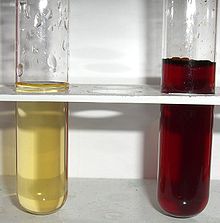Iron (III) thiocyanate
| Structural formula | ||||||||||||||||
|---|---|---|---|---|---|---|---|---|---|---|---|---|---|---|---|---|
|
|
||||||||||||||||
| General | ||||||||||||||||
| Surname | Iron (III) thiocyanate | |||||||||||||||
| other names |
Iron (III) rhodanide |
|||||||||||||||
| Molecular formula | Fe (SCN) 3 | |||||||||||||||
| Brief description |
blood red crystals |
|||||||||||||||
| External identifiers / databases | ||||||||||||||||
|
||||||||||||||||
| properties | ||||||||||||||||
| Molar mass | 230.09 g mol −1 | |||||||||||||||
| Physical state |
firmly |
|||||||||||||||
| safety instructions | ||||||||||||||||
|
||||||||||||||||
| As far as possible and customary, SI units are used. Unless otherwise noted, the data given apply to standard conditions . | ||||||||||||||||
Iron (III) thiocyanate is a chemical compound . It can be isolated anhydrous in the form of violet-colored crystals Fe (SCN) 3 or trihydrate Fe (SCN) 3 · 3 H 2 O. In aqueous solution , the iron (III) - with the thiocyanate ions (SCN - ) form blood-red, octahedral complexes .
Iron (III) complexes
In aqueous solution, the following six are high-spin - Complex steps:
The most frequently represented octahedral complexes have a blood-red color due to their charge-transfer properties, which is why they are also known as charge-transfer complexes . Because of their intense colors, they are used in analytical chemistry .
The high-spin d 5 -electron configuration does not provide any ligand stabilization energy, which is why no complex geometry is preferred, provided that other influences remain unchanged. This explains the diversity of the stereochemistry of iron (III).
Extraction
Iron (III) thiocyanate is obtained from a reaction of iron (III) sulfate with barium thiocyanate . Here falls barium sulfate from. The Fe (SCN) 3 remains in the solution .
Analytical use
These complexes are used in analytical chemistry to detect iron (III) ions. If SCN - ions are added to a solution which contains iron (III) ions (e.g. by adding potassium thiocyanate), a blood-red color is obtained immediately. The iron (III) ions are now available as iron (III) complexes.
To ensure that they are really iron (III) ions, fluoride ions are added dropwise and the solution becomes discolored. The SCN - ions were exchanged with the F - ions. The resulting, more stable [FeF 5 (H 2 O)] 2− complex is colorless. Also oxalate ions may have a Fe (SCN) 3 [(C Fe solution by formation of the (yellow) 2 O 4 ) 3 ] 3- discolor complex.
literature
- Riedel , Janiak: Inorganische Chemie , 7th edition, de Gruyter, Berlin 2007, ISBN 978-3-11-018903-2 .
Individual evidence
- ↑ Entry on iron (III) thiocyanate. In: Römpp Online . Georg Thieme Verlag, accessed on December 29, 2014.
- ↑ This substance has either not yet been classified with regard to its hazardousness or a reliable and citable source has not yet been found.
- ^ Riedel, Janiak: Inorganische Chemie , 7th edition, de Gruyter, Berlin 2007, ISBN 978-3-11-018903-2 , p. 854.
- ↑ Holleman, Wiberg: Textbook of Inorganic Chemistry , 102nd Edition, 2007, p. 1659.
- ↑ Riedel, Janiak: Inorganische Chemie , 7th edition, de Gruyter, Berlin 2007, ISBN 978-3-11-018903-2 , p. 713.
- ^ Holleman, Wiberg: Textbook of Inorganic Chemistry , 102nd Edition, 2007, p. 1660.
![{\ displaystyle \! \ \ mathrm {[Fe (SCN) (H_ {2} O) _ {5}] ^ {2+}}}](https://wikimedia.org/api/rest_v1/media/math/render/svg/41cf58f229088ce1c439d33311b35094eb4426d1)
![{\ displaystyle \! \ \ mathrm {[Fe (SCN) _ {2} (H_ {2} O) _ {4}] ^ {+}}}](https://wikimedia.org/api/rest_v1/media/math/render/svg/36bb6f63033660af64c3517a09cc852fa46ef59f)
![{\ displaystyle \! \ \ mathrm {[Fe (SCN) _ {3} (H_ {2} O) _ {3}]}}](https://wikimedia.org/api/rest_v1/media/math/render/svg/f274f52cfd8f635c6aea4d79cd1b1725daf06719)
![{\ displaystyle \! \ \ mathrm {[Fe (SCN) _ {4} (H_ {2} O) _ {2}] ^ {-}}}](https://wikimedia.org/api/rest_v1/media/math/render/svg/29b378a4f2eadabed312f55ea52052a1a48fecbd)
![{\ displaystyle \! \ \ mathrm {[Fe (SCN) _ {5} (H_ {2} O)] ^ {2-}}}](https://wikimedia.org/api/rest_v1/media/math/render/svg/ac5225eca2c3d27a51339d8b957e76601069500e)
![{\ displaystyle \! \ \ mathrm {[Fe (SCN) _ {6}] ^ {3-}}}](https://wikimedia.org/api/rest_v1/media/math/render/svg/72c66f96bff65abe90b0474a6f14569eba6e3377)

